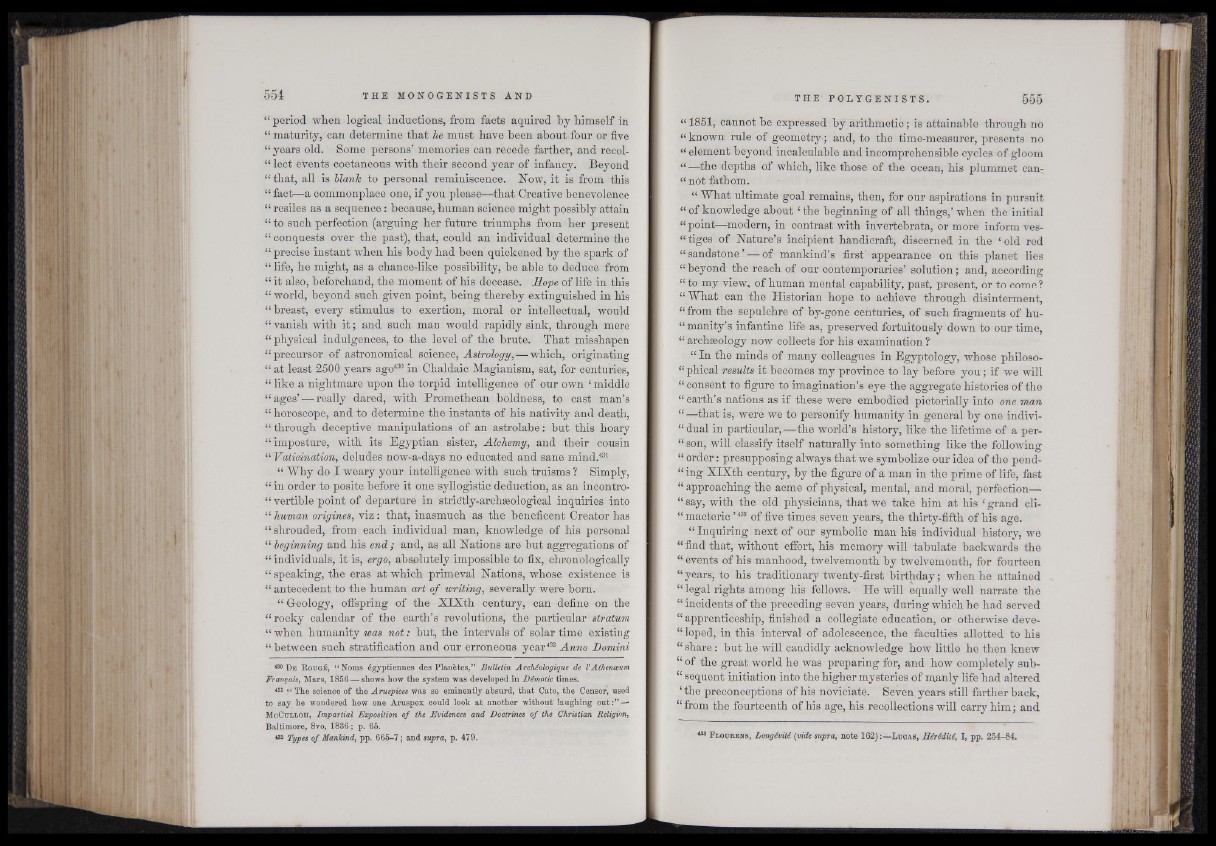
period when logical inductions, from facts aquired by himself in
maturity, can determine that he must have been about four or five
years old. Some persons’ memories can recede farther, and recollect
events coetaneous with their second year of infancy. Beyond
that, all is blank to personal reminiscence. Dow, it is from this
fact—a commonplace one, if you please—that Creative benevolence
resiles as a sequence : because, human science might possibly attain
to such perfection (arguing her future triumphs from her present
conquests over the past), that, could an individual determine the
precise instant when his body had been quickened by the spark of
life, he might, as a chance-like possibility, be able to deduce from
it also, befotehand, the moment of his decease. Hope of life in this
world, beyond such given point, being thereby extinguished in his
breast, every stimulus to exertion, moral or intellectual, would
vanish with it ; and such man would rapidly sink, through mere
physical indulgences, to the level of the brute. That misshapen
precursor of astronomical science, Astrology, — which, originating
at least 2500 years ago430 in Chaldaic Magianism, sat, for centuries,
like a nightmare upon the torpid intelligence of our own ‘ middle
ages’ — really dared, with Promethean boldness, to cast man’s
horoscope, and to determine the instants of his nativity and death,
through deceptive manipulations of an astrolabe : but this hoary
imposture, with its Egyptian sister, Alchemy, and their cousin
Vaticination, deludes now-a-days no educated and sane mind.431
“ Why do I weary your intelligence with such truisms ? Simply,
in order to posite before it one syllogistic deduction, as an incontrovertible
point of departure in stritftly-archæological inquiries into
human origines, viz : that, inasmuch as the beneficent Creator has
shrouded, from each individual man, knowledge of his personal
beginning and his end ; and, as all Dations are but aggregations of
individuals, it is, ergo, absolutely impossible to fix, chronologically
speaking, the eras at which primeval Dations, whose existence is
antecedent to the human art of writing, severally were born.
“ G-eology, offspring of the XTXth century, can define on the
rocky calendar of the earth’s revolutions, the particular stratum
when humanity was not : but, the intervals of solar time existing
between such stratification and our erroneous year432 Anno Domini
430 D e R o u g e , “ Noms égyptiennes des Planètes,” Bulletin Archéologique de VAthenoeum
Français, Mars, 1856 — shows how the system was developed in Démotic times.
431 f| The science of the Aruspices was so eminently absurd, that Cato, the Censor, used
to say he wondered how one Aruspex could look at another without laughing out:” —
M c C u l l o h , Impartial Exposition of the Evidences and Doctrines of the Christian Religion,
Baltimore, 8vo, 1836 ; p. 65.
482 Types of Mankind, pp. 665-7 ; and supra, p. 479.
y 1851, cannot be expressed by arithmetic; is attainable through no
“ known rule of geometry-; and, to the time-measurer, presents no
“ element beyond incalculable and incomprehensible cycles of gloom
“ —the depths of which, like those of the ocean, his plummet can-
“ not fathom.
“ What ultimate goal remains, then, for our aspirations in pursuit
“ of knowledge ahout4 the beginning of all things,’ when the initial
“ point—modern, in contrast with invertebrata, or more inform ves-
“ tiges of Dature’s incipient handicraft, discerned in the ‘old red
“ sandstone’-—of mankind’s first' appearance on this planet lies
“ beyond the reach of our contemporaries’ solution; and, according
“ to my view, of human mental capability, past, present, or to come?
“What can the Historian hope to achieve through disinterment,
“ from the sepulchre of by-gone centuries, of such fragments of hu-
I manity’s infantine life as, preserved fortuitously down to our time,
“ archaeology now collects for his examination ?
“ In the minds of many colleagues in Egyptology, whose philoso-
1 phical results it becomes my province to lay before you; if we will
“ consent to figure to imagination’s eye the aggregate histories of the
“ earth’s nations as if these were embodied pictorially into one man
“ —that is, were we to personify humanity in general by one individ
u a l in particular,—the world’s history, like the lifetime of a per-
“ son, will classify itself naturally into something like the following
“ order: presupposing always that we symbolize our idea of the pend-
“ ing XlXth century, hy the figure of a man in the prime of life, fast
“ approaching 'the acme of physical, mental, and moral, perfection—
“ say, with the old physicians, that we take him at his ‘ grand cli-
“macteric,43S of five times, seven years, the thirty-fifth of his age.
“ Inquiring next of our symbolic man his individual history, we
“ find that, without effort, his memory will tabulate backwards the
<! events of his manhood, twelvemonth hy twelvemonth, for fourteen
“ years, to his traditionary twenty-first birthday; when he attained
“ legal rights among his fellows. He will equally well narrate the
“ incidents of the preceding seven years, during which he had served
“ apprenticeship, finished a collegiate education, or otherwise deve-
“ loped, in this interval of adolescence, the faculties allotted to his
“ share: but he will candidly acknowledge how little he then knew
“ of the great world he was preparing for, and how completely sub-
u sequent initiation into the higher mysteries of manly life had altered
‘ the preconceptions of his noviciate. Seven years still farther back,
“ from the fourteenth of his age, his recollections will carry him; and
483 F l o u r e n s , Longévité (vide supra, n o t e 162):—L u c a s , Hérédité, I, p p . 254-84.